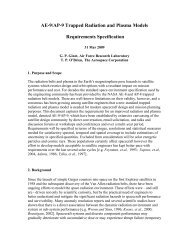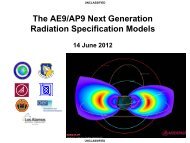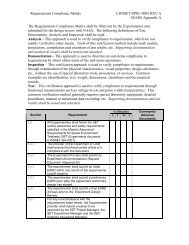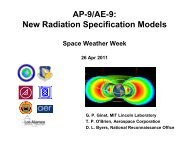Observation of the Solar Particle Events of October ... - IEEE Xplore
Observation of the Solar Particle Events of October ... - IEEE Xplore
Observation of the Solar Particle Events of October ... - IEEE Xplore
You also want an ePaper? Increase the reach of your titles
YUMPU automatically turns print PDFs into web optimized ePapers that Google loves.
DYER et al.: OBSERVATION OF SPEs OF OCTOBER/NOVEMBER 2003 FROM CREDO AND MPTB 3389<br />
Fig. 1. Proton flux measurements from CREDO-3 on MPTB between November 1997 and June 2004 show <strong>the</strong> underlying cosmic-ray modulation with a minimum<br />
intensity in August 2000, toge<strong>the</strong>r with a number <strong>of</strong> very significant SPEs, seen as spikes, including <strong>the</strong> Halloween events <strong>of</strong> 2003.<br />
Fig. 2. Time variations <strong>of</strong> proton fluxes for <strong>the</strong> Halloween events. There are three orbits <strong>of</strong> missing data. For most <strong>of</strong> each orbit MPTB is fully exposed<br />
geomagnetically to solar particles but on ei<strong>the</strong>r side <strong>of</strong> perigee <strong>the</strong>re is geomagnetic screening, leading to <strong>the</strong> lowest levels and exposure to inner-belt protons,<br />
seen as spikes in <strong>the</strong> data.<br />
aimed at space testing a number <strong>of</strong> advanced technologies<br />
in a radiation-stressing, highly inclined elliptic orbit<br />
(39 200 1200 km) having a period <strong>of</strong> 12 hours. Results<br />
from CREDO up until July 2002, toge<strong>the</strong>r with an instrument<br />
description, have been presented in [2] and [3] while results on<br />
SEE are given in [3] and [4].<br />
The proton telescope measures fluxes <strong>of</strong> protons <strong>of</strong> energy<br />
greater than 38 MeV, while <strong>the</strong> ion monitor measures LET<br />
spectra in 16 channels which cover <strong>the</strong> range from 100 to<br />
20 000 MeV/(g cm ), with an upper channel providing an<br />
integral measurement above <strong>the</strong> higher level. These complementary<br />
measurements enable both proton-induced and<br />
ion-induced SEE to be quantified. Essentially continuous data<br />
coverage has been obtained from switch-on in November 1997<br />
until <strong>the</strong> present (July 2004) with <strong>the</strong> exception <strong>of</strong> a few periods<br />
<strong>of</strong> eclipses at around perigee and o<strong>the</strong>r minor data outages.<br />
IV. RESULTS<br />
A. Time Variations <strong>of</strong> Proton Fluxes<br />
The time variation in <strong>the</strong> proton fluxes is shown in Fig. 1 for<br />
<strong>the</strong> period from November 1997 to June 2004. The underlying,<br />
slowly varying level is from cosmic rays for which flux levels<br />
reached a minimum in August 2000 when <strong>the</strong>y were a factor 2.7<br />
lower than at <strong>the</strong> start <strong>of</strong> <strong>the</strong> mission. They have since recovered<br />
by a factor 1.5. The significant SPEs are seen as spikes lasting<br />
for several days each. Dates are given for <strong>the</strong> most significant<br />
increases, including <strong>the</strong> Halloween events. It can be seen that<br />
<strong>the</strong> event <strong>of</strong> <strong>October</strong> 28–29, 2003, is comparable to <strong>the</strong> largest<br />
<strong>of</strong> <strong>the</strong> previous events <strong>of</strong> this solar maximum. Unfortunately <strong>the</strong><br />
large SPE on November 9, 2000, was missed.<br />
The time pr<strong>of</strong>ile <strong>of</strong> <strong>the</strong> Halloween events is given in Fig. 2.<br />
Unfortunately three orbits <strong>of</strong> data were lost, one on <strong>October</strong> 29






